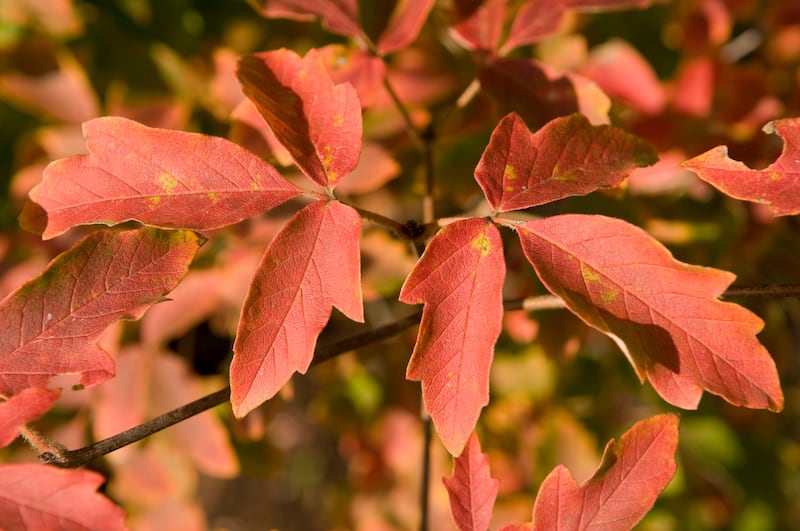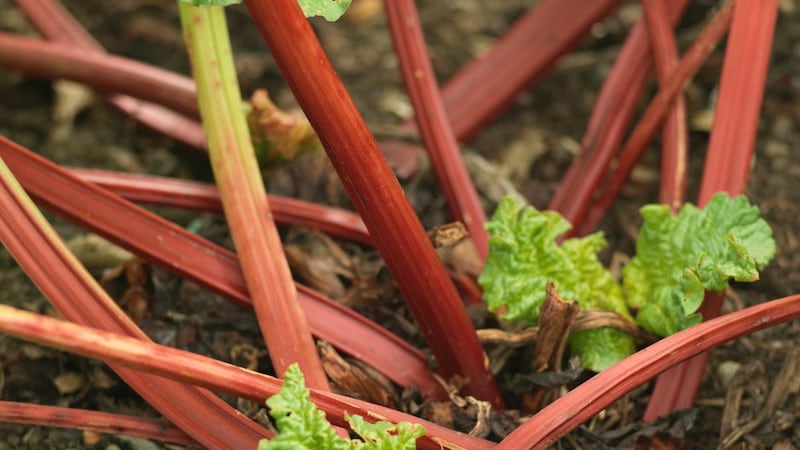It hasn’t been a vintage year for autumn colour. For this we can blame the preponderance of wet, windy, overcast weather and the shortage of dry, still, sunny autumnal days combined with a lack of frosty autumnal nights. It’s the latter combination in particular that encourages the production of those bright red, wine and purple leaf pigments traditionally associated with this time of year.
These are known as anthocyanins, and are the result of a chemical reaction caused by plant sugars becoming trapped in the foliage of deciduous species as the leaves ready themselves to fall. Those same plant sugars are produced far more abundantly on bright, sunny days. When the latter are followed by cold, clear autumnal nights, the magic happens. Cool night temperatures cause the leaves’ fine network of veins to contract, preventing those same sugars from being easily transported down into the root system of the plant. Instead, the concentration of sugars steadily increases, at which point they combine with plant sap to become anthocyanins.
[ Autumn comes bearing gifts for the gardenOpens in new window ]
Viewed this way, deciduous trees and shrubs are paragons of good planning and preparedness, their parsimonious squirrelling away of precious resources in autumn essential to their survival through the cold, short, dark days and long nights of winter. With photosynthesis out of the question until they come into leaf again the following spring, they carefully husband their resources by concentrating instead on root growth underground as long as soil temperatures are above freezing. So next time you look at a deciduous tree or shrub in its winter nakedness, don’t think of it as sleeping. Instead, it’s the arboreal equivalent of a duck in water, calm above the surface but paddling hard to stay afloat.
As for that final flash of brilliant autumn foliage colour, some woody species are naturally much better at providing it than others. If you can give them a sheltered site in dappled shade and a cool, humus-rich, neutral to mildly acidic soil, then it’s hard to beat Japanese acers for both the refined elegance and the extraordinarily vivid hues of their autumnal leaves. An example is the slow-growing Acer palmatum ‘Dissectum’. It is compact enough to keep in a large container, its finely cut foliage turning to glorious shades of gold and brilliant orange at this time of year. Although fully hardy, those feathery leaves need protecting from scorching cold winds, hence the need for shelter.
For larger gardens the paperbark maple, Acer griseum, is a wonderful choice and much less fussy. Happy in an average soil and either sun or light shade, it produces a magnificent display of fiery autumnal foliage while its textural, peeling, cinnamon-coloured bark continues to offer winter interest long after its leaves have fallen to the ground. Its cousin Acer rubrum ‘October Glory’ is also known for its outstanding autumn colour as indeed are many other species of acer.

So too is the Persian ironwood, Parrotia persica, whose common name is a reference to the famed toughness of its wood. A magnificently mature specimen can be seen growing just inside the main entrance to the National Botanic Gardens in Glasnevin. The variety known as Parrotia ‘Felicié’ is particularly noted for its long-lasting autumn colour. For small gardens, Parrotia persica ‘Vanessa’ is a much more compact, vertical form with an average height and spread of just 3m x 1m. Both are fully hardy, happy in full sun or light shade and like a moist but free-draining soil.
The burnt-sugar smell of toffee apples is another quintessential autumnal tradition, one that the foliage of katsura (Cercidiphyllum japonicum) provides as its vividly colourful, heart-shaped leaves start to fall to the ground at this time of year. “Overwhelming in its overall attractiveness” is how one leading dendrologist has memorably described this outstandingly decorative tree. Many different varieties are available, including some compact forms suitable for smaller gardens such as the slow-growing Cercidiphyllum ‘Glowball’, also known for its exceptionally colourful autumnal foliage in shades of gold, pink and copper. Fully hardy but best in shelter, katsura is happy in full sun or light shade and in a moist but free-draining, average soil.
For seasonal foliage shades of pink and peach, seek out the glorious Chinese dogwood known as Cornus kousa var chinensis. A compact, hugely decorative tree suitable for small gardens that offers multiple seasons of interest, its brilliantly colourful autumn foliage is one of its many glories. One of the best varieties is Cornus kousa var chinensis ‘Osborn’, which is exceptionally floriferous (the species is prized for its display of starry white flowers or bracts in early summer, which are followed by pretty pink fruits) as well as for its outstandingly colourful and long-lasting display as it prepares for leaf fall. Its close relative, Cornus kousa ‘Teutonia’, is also well worth seeking out. It is exceptionally compact and suitable for small gardens, growing to an average height and spread of just three metres. Both are fully hardy and like a sunny, sheltered spot and – yet again – a moist but free-draining, humus-rich, neutral to acid soil.
[ Tulips, erythroniums and trilliums: aristocratic bulbs for planting seasonOpens in new window ]
With a name such as Liquidambar, it’s not surprising that the sweet gum (Liquidambar styraciflua) is a firecracker of a tree whose luminous autumnal display is one of the highlights of many Irish gardens, parks and arboretums. The problem for some is its size, which in maturity can easily reach a height and spread of 20m x 8m. But a new variety, Liquidambar ‘Slender Silhouette’, has a much neater, strongly columnar habit (20m x 2m). Size aside, another thing to bear in mind is the sweet gum tree’s need for some summer heat to ripen the wood, without which its branches can become brittle. On the other hand, our coolish Irish summers offer a curious advantage, which is that they discourage this ornamental tree from fruiting, a problem in warmer parts of the world where its spiny fruits can be slippery and messy underfoot. Proof, much needed, that even our grey Irish clouds have a silver lining.
This week in the garden

As autumn takes a firm grip on our gardens and allotments, take advantage of any dry days to weed and mulch beds for winter. Not only will this protect soil structure and fertility and boost plant health, but it will save you time and hard work next spring.
Delicious and nutritious, rhubarb is such a useful and productive plant, as well as one that until recently was traditionally grown in a great number of Irish gardens. Now is a great time to plant it, choosing a spot in full sun/light shade and giving it a deep, rich, moist but free-draining soil. Recommended varieties include R ‘Timperley Early’; R ‘Victoria’ and R ‘Raspberry Red’.
Dates for your diary
October 24th (7.30pm): National Botanic Gardens Autumn Lecture Series, National Botanic Gardens, Glasnevin, Dublin 9. How Plants Feed Themselves, a talk by Dr Colin Kelleher, free admission, see heritageireland.ie and eventbrite.ie for tickets.
Until Wednesday, October 26th around the country: The National Acorn Gathering, run by The Nature Trust and supported by Coillte and Forest Partners, encourages volunteers to collect acorns of native oaks to be used to propagate new trees to create new native woodlands. naturetrust.ie
















